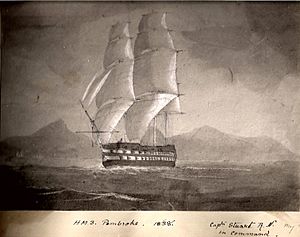HMS Pembroke (1812) facts for kids
 |
|
Quick facts for kids History |
|
|---|---|
| Name | HMS Pembroke |
| Ordered | 17 May 1808 |
| Builder | Wigram, Wells & Green, Blackwall Yard |
| Laid down | March 1809 |
| Launched | 27 June 1812 |
| Fate | Sold, 1905 |
| General characteristics | |
| Class and type | Vengeur-class ship of the line |
| Tons burthen | 1758 bm |
| Length | 176 ft (54 m) (gundeck) |
| Beam | 47 ft 6 in (14.48 m) |
| Depth of hold | 21 ft (6.4 m) |
| Propulsion | Sails |
| Sail plan | Full-rigged ship |
| Armament |
|
HMS Pembroke was a powerful warship of the Royal Navy. She was a "ship of the line," meaning she was big enough to fight in the main battle line. She had 74 guns and was launched on June 27, 1812. She was built at Blackwall Yard in England.
Contents
Early Adventures of HMS Pembroke
Soon after her launch, in December 1812, Pembroke got stuck on the shore near Portsmouth. Luckily, other Royal Navy ships helped pull her free. These ships were the frigates HMS Niobe and HMS Pomone, and the ship-sloop HMS Rosamond.
Attacking Fort Maurigio
In 1814, Pembroke was part of a group of ships led by Sir James Brisbane. On April 11, 1814, this group attacked Fort Maurigio in the Gulf of Genoa, near Monaco. The squadron included Pembroke, the French frigate Alcmene, and Aigle.
The ships fired at the fort until its guns stopped. Then, they attacked 20 other vessels. Four of these vessels were captured by the squadron. The crews of 15 other ships sank their own vessels to prevent them from being captured. However, Pembroke and her squadron were still able to take the valuable goods from these sunken ships.
Testing New Ideas
In 1836, Pembroke joined an "experimental squadron." These squadrons were special groups of ships in the 1830s and 1840s. Their job was to test new ideas for ship design, weapons, building methods, and how ships moved.
Incident at Gibraltar
In March 1837, Pembroke ran aground, meaning she got stuck on the seabed, near Gibraltar. A French steamship named Minos came to help. With its assistance, Pembroke was successfully pulled free and floated again.
Later Life and Changes
In 1855, Pembroke was updated with a new type of engine called "screw propulsion." This meant she could now move using a propeller, not just sails.
Collision at Sea
On September 16, 1857, Pembroke was involved in a collision. She accidentally hit and sank a British ship called Lady Sale off the Isle of May. The Admiralty Court, which was like a special court for sea accidents, decided that Pembroke was responsible for the crash.
Final Years
In 1858, Pembroke was moved to the Coastguard. The Coastguard helps protect the coast and ships. From 1887, she was used as a "base ship," which means she stayed in one place and served as a floating office or home for sailors. In 1890, she was renamed HMS Forte. She became a "receiving hulk", a ship that was no longer used for active sailing but served as a floating barracks or storage. Finally, in 1905, she was sold out of the navy.



